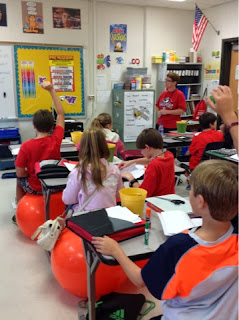Today, I got the chance to stop into 6th grade and some main floor classes. Take a look at some of the best practices I witnessed as I peeked...

Conferencing with students...This is a strategy that I think has HUGE growth potential for increasing student learning. When students are working independently, conference with them. Here are some examples across multiple contents of how this can be used....
1) During silent reading, check in with individual students to reinforce their application of learning outcomes. For example, if you are focusing on plot, ask students to share the setting, conflict, climax, etc. of the book they are reading...it's a good opportunity to require them to think.
2) During writing time, have students show you their examples to prove their thesis. This will work if they are writing using the RAP strategies, writing DBQ essays or finalizing conclusions from a inquiry-based lab.
3) During stations, make yourself one of the stations. You can group students by specific skills to provide remediation and/or enrichment.
The trick is to not stress yourself out...you don't need to get to every student everyday, but make sure you are eventually getting to all of them.
Co-Teaching...What's noteworthy are the roles of each of the teachers. This is a true team-teaching model where the special education teacher is serving as the primary with the general ed. teacher providing tips and supplementary ideas. Great collaboration, ladies!
Holding kids accountable...In this class, students are required to read outside of class, demonstrating their comprehension on a quick quiz. Building their homework stamina over time helps to prepare students for the next year's expecations.
More Reflection...Here, students have identified what they learned this week.
Authentic Learning...In the first two pictures, a student has designed a tutorial for others to use on Google Drive applications. She has provided detailed directions and screenshots of how to change the color of folders...I need this skill. The final picture is of student problem-solving projects...How do you make a catapult that will actually shot objects across the room? Now, I think every teacher would enjoy that! :)



More Authentic Learning...Students are studying mean, median, and mode. And, what more relevant way in this post-season climate than with Cardinal baseball salaries? I was also impressed with the use of wireless and one-note on the tablet to help facilitate that learning.

Differentiating for talent...Art students are not limited in their expression. Instead, they have loose deadlines so that they can work at their pace and the degree of difficulty they prefer. All students are held to basic principles, but those who want to expand are encouraged to do so. Others, who finish sooner, move on to the next essential learning task. This is the same concept of Writer's Workshop, just a different genre.
Teaching Organization...Kids don't come to us prepared to be well-organized. Okay...some do, but we have to explicitly teach most how to be responsible middle school students. In this class, students were required to write their assignment in the agenda book (or, use their devices if they had another tool). The trick is to reinforce the expectation. I used to go around and thank kids who completed their agenda books - it's amazing how much kids crave that positive reinforcement. Even those who didn't want to record assignments, did record them.
Preparing for Student-Led Conferences...Check out this modeling in action.



























































